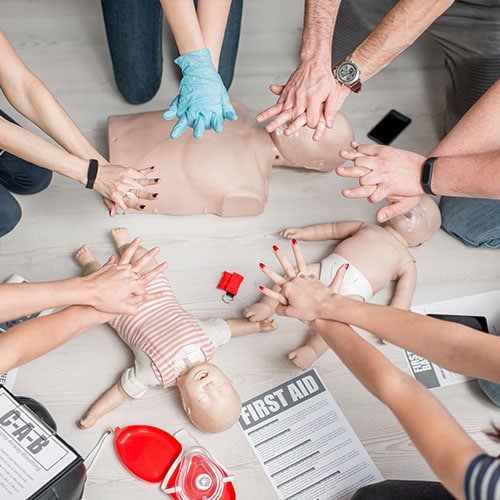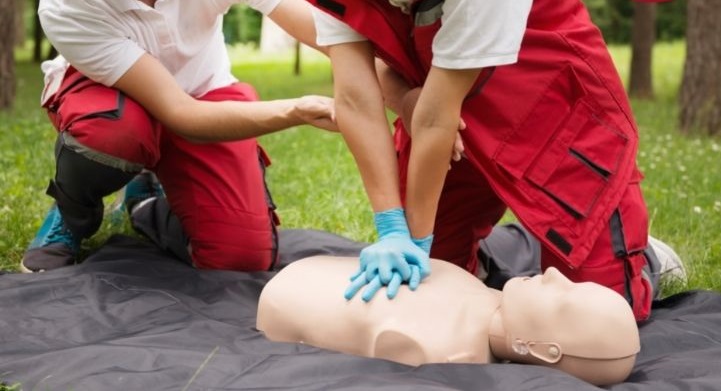Introduction
In our swiftly altering globe, the importance of emergency treatment can not be underrated. Whether in a corporate environment, school, or in the house, recognizing exactly how to react efficiently throughout a medical emergency situation can save lives. However, with wonderful responsibility comes the need for recognizing the policies governing emergency treatment methods. This article intends to provide an extensive review of first aid policies that every carrier should know. We will look into numerous facets-- from vital certifications to the subtleties of CPR programs-- ensuring you leave outfitted with expertise and confidence.
Table of Contents
Understanding Emergency treatment Regulations- 1.1 Value of First Aid Training 1.2 Legal Implications of First Aid
- 2.1 Sorts of Emergency Treatment Courses 2.2 Selecting the Right Training Course for You
- 3.1 Comprehending mouth-to-mouth resuscitation Techniques 3.2 Relevance of CPR Certification
- 4.1 Advantages of Mixed Training 4.2 Just how to Discover an Integrated Course
- 5.1 Who Demands an Emergency Treatment Certificate? 5.2 Credibility and Renewal of Certifications
- 6.1 National Safety Council (NSC) 6.2 American Red Cross Standards
- 7.1 OSHA Guidelines for Workplace Safety 7.2 Company Responsibilities in Emergency Treatment Training
- 8.1 Basic Steps in Emergency Situation Response 8.2 Duty of an Initial Responder
- 9.1 Usual False impressions concerning Emergency treatment 9.2 Conquering Barriers to Training
- 10.1 Virtual Understanding Opportunities 10.2 Developments in First Aid Equipment
Understanding First Aid Regulations
Importance of Emergency treatment Training
First aid training is not simply a valuable ability; it's a crucial part of our social material that encourages individuals to act decisively during emergencies.
- Life-Saving Skills: Understanding basic emergency treatment techniques can significantly raise survival rates in emergencies. Confidence Building: People learnt first aid usually really feel extra confident and prepared when faced with clinical situations.
Legal Effects of First Aid
Understanding the legal structure surrounding emergency treatment is essential for anybody giving aid throughout emergencies.
- Good Samaritan Laws: The majority of states have regulations safeguarding those that make aid voluntarily from lawful responsibility, as long as their actions are sensible and intended to help. Negligence Considerations: If a trained service provider acts carelessly or falls short to carry out essential life-saving procedures, they can encounter legal consequences.
First Aid Courses Overview
Types of Emergency treatment Courses
There are numerous sorts of emergency treatment training courses offered, each customized to satisfy various needs:
- Basic Life Assistance (BLS): Perfect for healthcare specialists requiring innovative skills. Standard First Aid: Covers crucial abilities suitable for laymans and non-medical personnel. Advanced Cardiac Life Support (ACLS): Targets healthcare providers working with critically ill patients.
Choosing the Right Program for You
When selecting a course, consider your goals and conditions:

- Are you looking for certification for office compliance? Do you require skills certain to child care or senior assistance?
Researching local providers can aid enhance your selection based on location and solutions offered.
CPR and Its Significance
Understanding mouth-to-mouth resuscitation Techniques
Cardiopulmonary resuscitation (MOUTH-TO-MOUTH RESUSCITATION) is one of one of the most essential skills found out in any emergency treatment course:
- Compression Technique: Reliable upper body compressions can keep blood flowing to essential organs till professional aid arrives. Rescue Breaths: While much less stressed currently as a result of brand-new standards, rescue breaths remain an indispensable part of standard CPR training.
Importance of mouth-to-mouth resuscitation Certification
Obtaining accreditation via identified companies makes sure expertise in performing mouth-to-mouth resuscitation:
- Many companies need present accreditation as component of their safety and security protocols. It increases overall self-confidence when facing potential cardiac emergencies.
First Help and CPR Course Integration
Benefits of Consolidated Training
Taking a combined emergency treatment and CPR training course provides numerous benefits:
- It streamlines training by covering both areas simultaneously. Participants get comprehensive understanding appropriate throughout various scenarios.
How to Locate an Integrated Course
Searching for integrated training programs calls for some tactical preparation:
- Look for neighborhood recreation center or hospitals offering such courses. Online systems might also give online options customized towards active professionals.
First Help Certification Requirements
Who Needs an Emergency treatment Certificate?
Various industries demand qualification from employee:
- Educational establishments commonly need teachers and trains to hold valid certificates. Healthcare settings demand continuous training among personnel members.
Validity and Renewal of Certifications
Most qualifications have expiry dates:
- Regularly restoring certifications makes sure that providers remain up-to-date with current practices.
Regulatory Bodies Governing First Aid
National Security Council (NSC)
The NSC plays a pivotal function in establishing criteria for security training throughout the United States:
- They supply sources, products, and assistance for both teachers and students alike.
American Red Cross Standards
The American Red Cross uses considerable training programs aligned with national criteria:
- Their educational program consists of hands-on method, guaranteeing participants establish practical skills alongside theoretical knowledge.
Workplace Laws on First Aid
OSHA Standards for Work environment Safety
The Occupational Safety and Wellness Management (OSHA) lays out assumptions concerning work environment safety measures:
|Demand|Summary|| -------------|-------------|| Accessibility|Companies have to make sure accessibility to ample first-aid resources in all times|| Educated Employee|Designated workers must be learnt standard first aid|
Employer Responsibilities in First Aid Training
Employers birth significant responsibilities concerning worker safety:
- Providing appropriate training sessions frequently aids reduce office injuries.
Emergency Response Protocols
Basic Action in Emergency Response
An efficient emergency situation response method can dramatically enhance outcomes during dilemmas:
Assess the circumstance safely. Call emergency solutions if needed. Provide essential treatment until specialist assistance arrives.Role of an Initial Responder
First responders play an important duty within emergency situation scenarios by delivering timely help while waiting for innovative clinical treatment:
- Their prompt action often makes a considerable difference between life and fatality scenarios.
Challenges in Implementing First Aid Training
Common Misconceptions concerning First Aid
Misunderstandings bordering first aid can prevent effective responses during emergencies:
Myth vs Fact Table
|Misconception|Reality|| ----------------------------------|------------------------------------------|| Only medical care experts must provide first aid|Anybody can discover standard strategies|| Using an AED is hazardous|AEDs are made for public use|
Overcoming Obstacles to Training
Several barriers exist Mackay first aid workshops that might hamper individuals from seeking first aid programs;
Key Barriers
- Time Constraints: Hectic schedules make it difficult for many people to locate time for training sessions. Financial Limitations: Cost may hinder interested candidates from taking part; however, several organizations offer subsidized training courses or grants especially focused on providing economic relief.
Future Patterns in Emergency treatment Training
Virtual Discovering Opportunities
With modern technology advancing quickly, on the internet systems have actually gotten appeal amongst learners seeking flexible alternatives;
- Real-time simulations enable individuals to involve proactively without requiring physical presence at standard locations; This approach improves accessibility while suiting varied learning styles!
Innovations in First-Aid Equipment
Emerging technologies are revolutionizing just how we come close to first-aid prep work;


Examples Include
- Smart Plasters-- equipped sensing units keep an eye on recovery progress! Mobile Apps-- using guidance based on customer input concerning signs and symptoms!
FAQs Regarding Making Sense Of First-Aid Regulations
Q1: What is included in a normal first-aid course?
A regular first-aid program covers topics such as injury treatment, crack management, shock therapy, choking interventions, together with CPR strategies customized towards numerous age groups!
Q2: How frequently do I need to restore my CPR certification?
Most companies recommend restoring your qualification every 2 years; staying well-informed ensures reliable feedbacks throughout emergencies!
Q3: Can I take an on-line first-aid course?
Definitely! Many reliable companies provide on the internet options enabling learners adaptability while maintaining top notch requirements through interactive content!
Q4: Exists any age requirement for taking these courses?
Typically speaking-- no! Kids aged ten or older can get involved under parental guidance; nevertheless-- it's a good idea that adults accompany them throughout lessons!
Q5: Exactly how do I pick in between various providers providing comparable courses?
Examine reviews/testimonials from previous participants together with examining accreditation status prior to choosing; this will certainly ensure high quality education gave meets market standards!
Conclusion
In recap-- making sense outta laws surrounding vital areas like 'first-aid' & & 'MOUTH-TO-MOUTH RESUSCITATION' is essential not only skillfully however personally as well! As seen throughout this post-- countless variables add towards ensuring proper responsiveness throughout clinical emergencies consisting of understanding needed accreditations-- in addition to identifying difficulties encountered whilst applying reliable programs within community/workplace settings alike! By spending time/resources into gaining proficiency through relevant courses-- you'll be better positioned than in the past-- must fate present its unpredictability knocking at your door! Constantly remember-- the capacity you have today can potentially save another person's tomorrow!